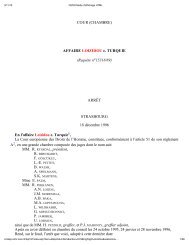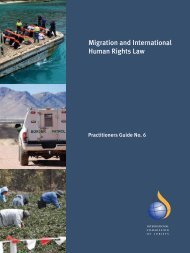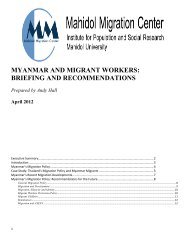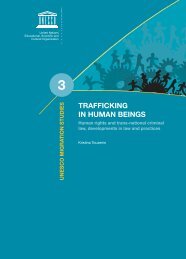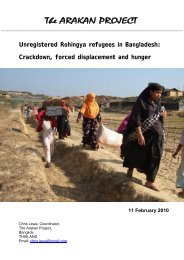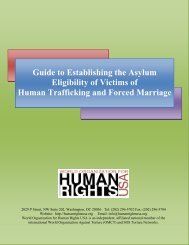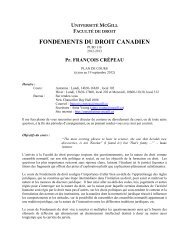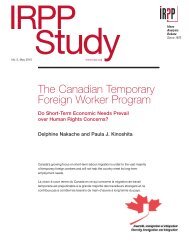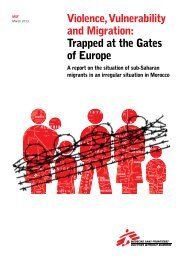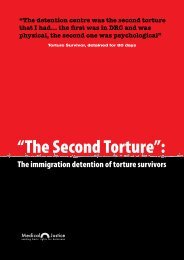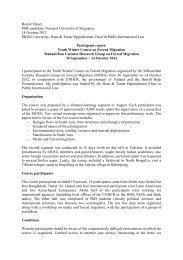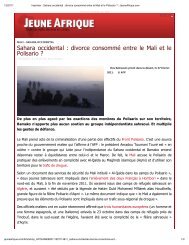Access to Justice for Migrant Workers in BC - West Coast Domestic ...
Access to Justice for Migrant Workers in BC - West Coast Domestic ...
Access to Justice for Migrant Workers in BC - West Coast Domestic ...
Create successful ePaper yourself
Turn your PDF publications into a flip-book with our unique Google optimized e-Paper software.
Data Collection<br />
The researchers collected data through a variety of methods. An analysis of current<br />
research and report<strong>in</strong>g about the TFWP was conducted <strong>to</strong> help construct a framework <strong>for</strong><br />
the research and <strong>to</strong> allow <strong>for</strong> the triangulation of WCDWA’s f<strong>in</strong>d<strong>in</strong>gs with other sources.<br />
Three focus groups were held with temporary <strong>for</strong>eign workers with a researcher <strong>in</strong>troduc<strong>in</strong>g<br />
the various <strong>to</strong>pics <strong>for</strong> discussion then allow<strong>in</strong>g the participants <strong>to</strong> discuss issues broadly<br />
with<strong>in</strong> the framework and <strong>to</strong> contribute personal examples and testimony. A second<br />
researcher was present at the focus groups <strong>to</strong> aid <strong>in</strong> note tak<strong>in</strong>g. The research groups were<br />
conducted <strong>in</strong> collaboration with the Agricultural <strong>Workers</strong> Alliance of Abbots<strong>for</strong>d and<br />
<strong>Migrant</strong>e <strong>BC</strong>. A number of semi-structured <strong>in</strong>terviews were conducted, either by phone or<br />
face-<strong>to</strong>-face, with current and <strong>for</strong>mer live-<strong>in</strong> caregivers, seasonal agricultural workers and<br />
immigrants <strong>in</strong> the stream <strong>for</strong> ‘lower-skilled’ workers. Additionally WCDWA used data<br />
collected <strong>for</strong> cases that it has dealt with <strong>in</strong> recent years that contribute <strong>to</strong> the general body<br />
of evidence. All research participants voluntarily <strong>to</strong>ok part <strong>in</strong> the research process and gave<br />
permission <strong>for</strong> their testimony and experiences <strong>to</strong> be used <strong>in</strong> this report. All research<br />
participants were promised that their participation <strong>in</strong> the research would be anonymous.<br />
Pseudonyms have been used <strong>in</strong> the report <strong>to</strong> conceal the identity of those concerned.<br />
Report Outl<strong>in</strong>e<br />
This report consists of four parts: Part One sets the scene by first situat<strong>in</strong>g the TFWP<br />
with<strong>in</strong> the global context and with<strong>in</strong> the legal framework of Canada’s immigration system. It<br />
briefly describes the different immigration streams relevant <strong>to</strong> the research participants and<br />
WCDWA’s clients, provides a brief analysis of <strong>BC</strong> specific context, and discusses the<br />
Prov<strong>in</strong>cial Nom<strong>in</strong>ee Program (PNP) as a potential avenue <strong>to</strong> permanent residence. This<br />
section highlights the temporary nature of the status of migrant workers <strong>in</strong> the ‘lowerskilled’<br />
immigration categories and the limited options available <strong>for</strong> access<strong>in</strong>g permanent<br />
status <strong>for</strong> <strong>in</strong>dividuals enter<strong>in</strong>g Canada <strong>in</strong> these categories. It also highlights that those who<br />
are eligible <strong>to</strong> change their status from temporary <strong>to</strong> permanent are very much reliant on<br />
their employers <strong>to</strong> ma<strong>in</strong>ta<strong>in</strong> their eligibility.<br />
Part Two addresses the problems that occur as a result of the government’s usage of the<br />
TFWP as a way <strong>to</strong> manage so-called labor shortages through a review of current research<br />
and literature. Part Two argues that the precarious nature of the immigration status of<br />
temporary <strong>for</strong>eign workers, the employer driven focus of the system and the power<br />
imbalance between employers and employees creates a work environment filled with fear<br />
and uncerta<strong>in</strong>ty. Part Two also briefly looks at new legislation and government policies<br />
<strong>in</strong>troduced <strong>in</strong> the last two years and assesses how these may impact the employment and<br />
immigration situation <strong>for</strong> temporary <strong>for</strong>eign workers.<br />
6



